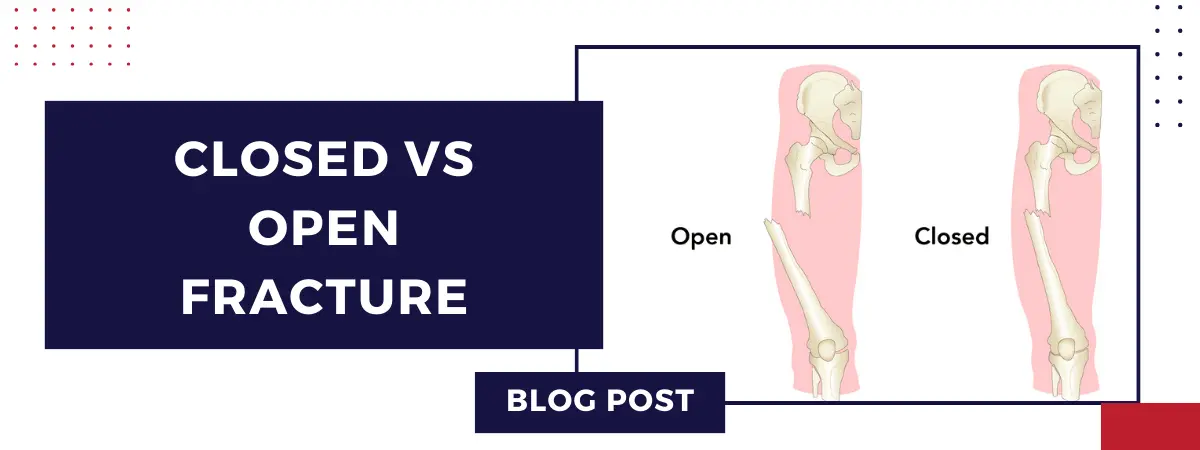Working Time
| Sunday - Friday | 07:00 AM - 11:00 PM |
| Saturday | Closed |
| Other Time | On Appointment |
Book Appointment

Introduction:
When it comes to bone fractures, understanding the distinction between closed and open fractures is crucial for accurate diagnosis and appropriate treatment. Closed fractures, also known as simple fractures, involve no break in the skin. Conversely, open or compound fractures occur when the broken bone pierces through the skin, creating a wound. This article explores the symptoms, treatments, and specialized care required for each type of fracture.
Symptoms of Open and Closed Fractures:
Both closed and open fractures share common symptoms resulting from an impact to the bone. These include redness, bruising, warmth, swelling, pain, and difficulty moving the affected body part. However, open fractures have an additional distinguishing feature—a visible wound near the injury site, with the broken bone potentially protruding through the skin.
Treatment for Closed Fractures:
Closed fractures, typically not puncturing the skin, often heal with conservative measures. Imaging, such as X-rays, helps assess the extent of the break. Pain relief medication is administered, and in less severe cases, surgical correction may not be immediately necessary. Immobilization through splints or casts aids the healing process. Follow-up appointments with X-rays monitor the recovery progress.
Reducing Displaced Bones:
For displaced fractures where bones have shifted, a closed reduction procedure is performed before immobilization. This involves aligning the bones externally, either under general or local anesthesia.
Treatment for Open Fractures:
Open fractures, frequently caused by severe trauma, necessitate immediate medical attention. Imaging and pain relief are administered, followed by a thorough cleaning of the wound, removing debris and sanitizing the injury site. Surgery may be required to stabilize and repair the broken bone, along with addressing damage to surrounding soft tissues.
Types of Fracture Surgery:
External Fixation:
Connects fractured bone parts using internal screws attached to an external frame.
Internal Fixation:
Involves surgical hardware like wires, pins, screws, plates, or rods to hold broken bones together.
Arthroplasty (Joint Replacement):
Replaces damaged joint parts with prosthetic components, suitable for fractures in joints like the knee or shoulder.
Bone Graft:
Recommended for severely displaced bones, involves using artificial, donor, or autologous bone grafts.
Other Treatments:
Traction may be applied to stretch muscles and tendons around a serious fracture, aiding in proper healing and alignment.
Specialized Fracture Care:
In cases involving the hand and wrist, consulting a Hand and Wrist Specialist is crucial for tailored care. Specific procedures such as arthroplasty or external fixation may be employed depending on the nature and location of the fracture.
Understanding the nuances between closed and open fractures ensures that individuals receive appropriate and timely medical intervention. Whether through conservative measures or advanced surgical procedures, the goal is to facilitate optimal healing, restore functionality, and minimize complications associated with these distinct types of bone injuries.
About the Author: Dr. Srikanth Varma Racherla
Dr. Srikanth Varma Racherla, a Specialist Orthopedic Surgeon in Al Nahda, Dubai, boasts a stellar academic background with an MBBS and MS in Orthopedics. His expertise spans Reconstructive Microsurgery, Hand Surgery, Peripheral Nerve Surgery, and Tendon Repairs and Transfers. Renowned for his proficiency in trauma, hand, and wrist surgeries, Dr. Srikanth Varma exemplifies a commitment to comprehensive and advanced orthopedic care, enriching the well-being of his patients with personalized and effective treatment.
Recent Posts
- Mastering the Keyboard: Proper Typing Techniques to Prevent Hand Fatigue and Injury
- Arthroscopic Surgery Explained: A Comprehensive Overview
- Comprehensive Guide to Managing Back Pain: Expert Insights from Dr. Srikanth Varma
- Understanding the Impact of Obesity on Orthopaedic Health: Insights by Dr. Srikanth Varma
- Expert Care for Pediatric Fractures in children by Dr. Srikanth Varma Racherla
- Recognizing Importance: National Hand Surgery Day 2024

